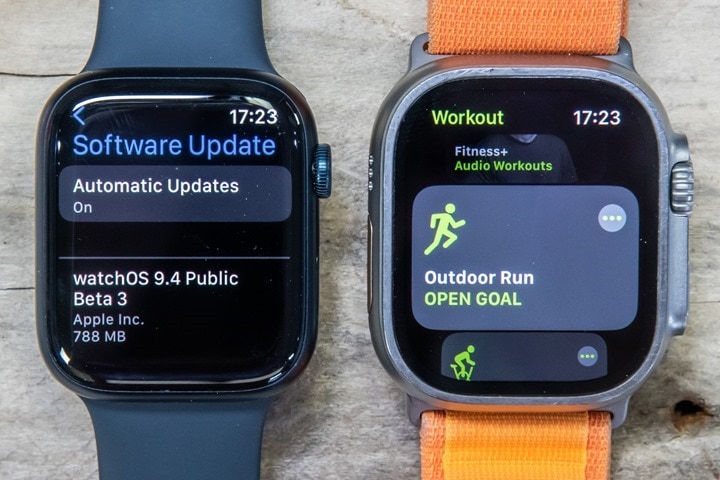Apple has quietly made a pretty substantial change to how and when running power is calculated in the Apple Watch, which will impact ultra and trail runners the most. Thankfully, this is a good change.
This change is part of a handful of other changes being made as part of the most recent Apple WatchOS software, currently in public beta as 9.4, which will likely release in the very near future. Apple has confirmed these changes are planned.
In total, there are basically three running-specific changes made in this version and the version prior:
1) Running power now includes “walking” periods (in the Outdoor Run profile specifically)
2) Running track mode will now ‘snap’ to 100m sections if within 5m of that point (just like Wahoo RIVAL does)
3) Running track mode now shows a new summary at end of the workout with per-loop times (in 9.3)
In addition, while not actually part of 9.4, note that Apple also concurrently rolled out Running Track mode support for a number of additional countries. I outlined all those here.
The running power change might sound minimal to non-runners, or even to road-runners or those just thinking about interval-type scenarios. But in reality, it’s a pretty massive shift for trail runners, or anyone else on steep terrain where the Apple Watch would previously fail to measure running power. Specifically, scenarios where you might have been exerting significant effort up a steep slope, but Apple wasn’t calculating any running power. As such, you couldn’t use it for pacing (and then further, it couldn’t be used to calculate any power-based training load/impact in 3rd party apps). This despite the fact that arguably these steeper sections were the ones with the highest power output.
Apple now agrees, and has implemented running power support during walk segments, joining the rest of the industry that captures that data.
First…as always, a quick reminder that there no agreed-upon standard for the definition of running power. As such, each company does it differently – either a lot differently or a little differently, depending on which biomechanics components they decide to include in their calculations. Further, another reminder that while it’s convenient mentally if running and cycling power numbers match for an individual, there’s no biomechanical reason why that should happen (and in fact, there are lots of reasons it shouldn’t).
With that, let’s look at what Apple did, based on some recent workouts. Here are some before/after update workouts to show the differences. I did these over the previous few weeks, and didn’t have Stryd or something else with me. Just Apple power and Garmin power, both wrist-based. If I was focused on a broader set of circumstances, it might matter more. But I’ve already done a COROS/Polar/Garmin/Apple running power comparison (Suunto added running power too, but that came later).
Here’s what some intervals looked like pre-change, you can see each time I recovered (walked) the power entirely dropped out on the Apple Watch. I’ve highlighted the yellow portion where you can see that the Apple Watch running power value has flat-lined to zero between each interval as I walked. Whereas the other units showed power values.
Now, compare that to a different workout (structure and time), and you can see very clearly the low-level of power being exerted during the recovery portions:
Again, the main point/benefit here isn’t really to capture running power during recovery. Rather, it’s to capture running power on steeper inclines, such as those in the mountains where many (if not most) trail runners will effectively fast-walk the steeper climbs. In those scenarios previously, the Apple Watch wouldn’t calculate any running power, as it didn’t meet the ‘Running’ detection threshold. Now it will, since any forward movement is counted.
Fun fact: There’s actually trail zigzagging up the face of this. It was gloriously sucky to run down, I’d rather have hiked up.
Now despite recently flying halfway across the world from the flat-Netherlands, I landed in also-flat Florida. As such, my ability to find a nice steep mountain is limited. The best I could do is a very short hill here in Amsterdam, which is just steep enough, briefly enough, to prove my point. Wearing one Apple Watch with the previous 9.3 firmware, and then another with the 9.4 beta, you can see side by side how these handle the same section while walking fast up this steep section.
Below shows how the older firmware in teal – which I’ve highlighted in yellow in spots – struggles anytime I’m walking, be it on flats, or steeper inclines. Whereas the newer firmware in purple handles it better. And in this case, not just previously struggled to show nothing – but also struggled with random inaccurate spikes at lower speeds. Again, solved with the newer firmware.
Cool, huh?
Now, if only they’d roll out running track mode to the Netherlands I’d be happy. I mean, it’s a small country – I’m not asking for too much, am I?
With that – thanks for reading!







0 Commentaires